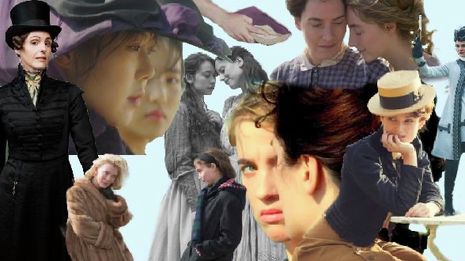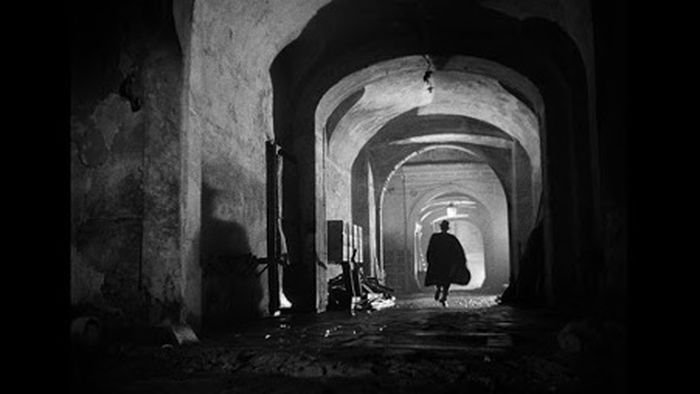The Rise of the Lesbian Period Drama
Leeza Isaeva investigates whether the flourishing phenomenon of lesbian period dramas is as radical as it first appears.

Waves crashing against grey pebble beaches, petticoats, and an appropriate dose of yearning: the trailer for Ammonite (2020), the eagerly awaited biopic starring Kate Winslet and Saoirse Ronan, has all the hallmarks of the lesbian period drama. Bearing an uncanny resemblance to Portrait of a Lady on Fire (2019), Ammonite is the latest in this recent trend, which also includes the likes of Elisa & Marcela (2019), Carol (2015), The Handmaiden (2016), and The Favourite (2018). This pattern is more than coincidental and, as much as ‘Saoirse-Ronan-in-a-period-drama’ is my favourite genre of film, it’s important to interrogate why the leading representations of love between women in film are all period pieces.
The initial appeal is self-evident: not only are period dramas aesthetically pleasing with corsets and manor houses, but lesbian period dramas come from a fundamental desire to see queer individuals and stories represented in both film and history, where they have so often been marginalised. The essence of these films is often to say that queer people and queer love stories have always existed: in an interview for Vox, Céline Sciamma, the director of Portrait of a Lady on Fire, explains that ‘the tragedy of lesbian life is not the tragedy of lesbian representation’, but ‘that we get erased from history’. Using a powerful female gaze, Sciamma weaves lesbian love back into film and history, opposing a long tradition of censorship and exclusion.
“Despite the sentiment of rewriting an inclusive history, if the new canon only tells the stories of those with significant privilege, this is far less radical than it may initially seem.”
However, while redressing some balance in the stories that are being told, the rise of the lesbian period drama continues to exclude other women. Despite their abundance, the vast majority of these films (with the notable exception of The Handmaiden) feature two white women. The exclusion of actors of colour from period dramas both perpetuates a false perception of a white-washed history and furthers the marginalisation of queer women of colour within the WLW (women-loving-women) community. The characters are often relatively wealthy, from an artistic background such as writers or painters, and present conventional and non-threatening models of femininity. Despite the sentiment of rewriting an inclusive history, if the new canon only tells the stories of those with significant privilege, this is far less radical than it may initially seem.
Period dramas also provide ample opportunity for the angst which saturates queer media. While avoiding forthright tragedy through the deaths of protagonists, and thus the notorious ‘Bury Your Gays’ trope, this manifests in other ways. Céline Sciamma doesn’t interpret Portrait of a Lady on Fire as a tragedy, yet the lovers are forced apart by a faceless patriarchy whose shadow looms over the film. In Elisa & Marcela, although their relationship survives the end of the film, Elisa must sacrifice her daughter for this outcome, causing significant emotional trauma; in Carol, Cate Blanchett’s character loses custody over her daughter as a result of her sexuality being perceived as deviant. While these films don’t simply equate queer stories with tragedy and there is often hesitant optimism for the relationship itself, the angst remains, with motherhood presented as incompatible with lesbian identity.
A sense of past intolerance also allows the audience to maintain a sense of distance from contemporary homophobia, and can encourage a teleological perspective of lesbian history. Elisa & Marcela tells the story of Spain’s first known same-sex marriage in 1901, when Elisa adopted a male identity to convince a priest to marry her to her lover, and but the couple are forced to flee the country when Elisa’s identity is discovered. Images of recently married women in Spain are shown as the credits roll, playing into the idea of a teleological sense of LGBTQ+ rights which starts and ends with the legal right to marriage. Past is depicted as oppressive, the present great.
“While we haven’t seen the last of [...] two women star[ing] longingly at each other in nineteenth-century attire, this isn’t a prescriptive depiction of the lesbian experience.”
At the same time, despite the many valid criticisms levelled at period dramas, it’s possible to find exceptions. The Handmaiden (2016) reimagines Sarah Waters’ novel Fingersmith as set in 1930s Korea during the Japanese occupation, and is a study of class, gender, and colonialism within an intoxicating romance. Gentleman Jack, the 2019 TV series, and Colette (2018) explore gender nonconformity and alternative modes of femininity within lesbian relationships.
Moreover, sensitive and provocative contemporary films about lesbian experiences are also being made. Booksmart (2019), an accurate and vulnerable coming of age story featuring a lesbian character, and Rafiki (2018), a Kenyan coming of age film centring two lesbians, both break away from the ‘period drama’ as the mainstream setting for a WLW film. For something more light-hearted, Happiest Season is an upcoming Christmas rom-com starring Kristen Stewart which satisfies the desire for a cheesy, heart-warming, and (hopefully) happy ending.
So, while we haven’t seen the last of the lesbian pining on a beach, waves crashing in the background while two women stare longingly at each other in nineteenth-century attire, this isn’t a prescriptive depiction of the lesbian experience, or of lesbian cinema, either. Following this year, I look forward to seeing not only historical lesbian accounts, but a more diverse range of queer female sexuality portrayed on the big screen, maybe even lit by electricity instead of candles.
 News / SU stops offering student discounts8 January 2026
News / SU stops offering student discounts8 January 2026 News / Uni-linked firms rank among Cambridgeshire’s largest7 January 2026
News / Uni-linked firms rank among Cambridgeshire’s largest7 January 2026 Comment / Plastic pubs: the problem with Cambridge alehouses 5 January 2026
Comment / Plastic pubs: the problem with Cambridge alehouses 5 January 2026 News / New movement ‘Cambridge is Chopped’ launched to fight against hate crime7 January 2026
News / New movement ‘Cambridge is Chopped’ launched to fight against hate crime7 January 2026 Comment / What happened to men at Cambridge?31 December 2025
Comment / What happened to men at Cambridge?31 December 2025










